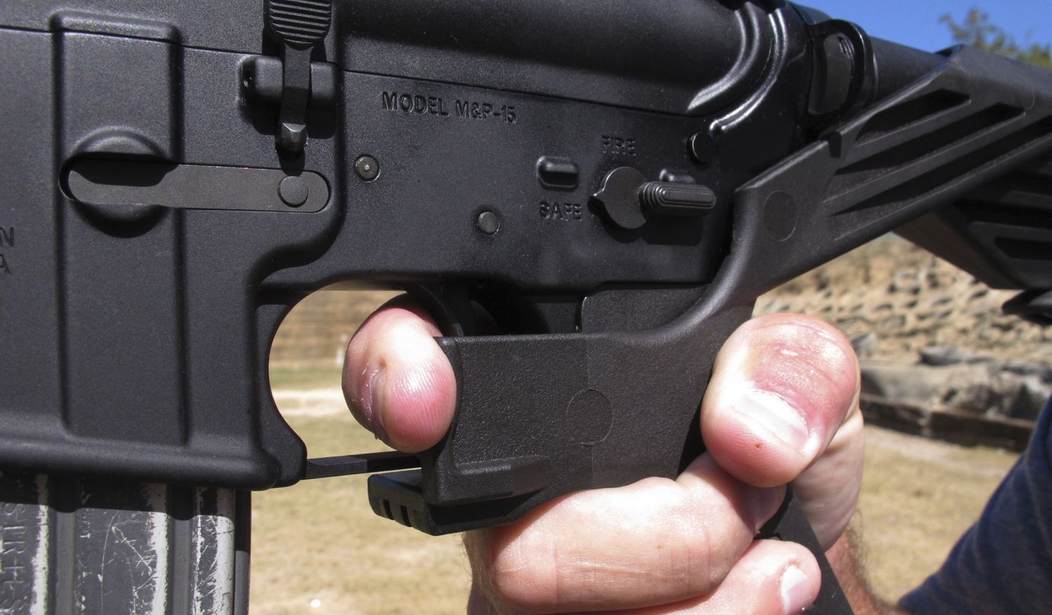Before the Las Vegas shooting, I never really thought of bump stocks as anything but a good way to waste ammo. Sure, bump fire looked like fun, but it wasn't accurate and I never really thought all that much about it.
In the aftermath of that horrific night, though, I saw what was happening and suddenly it wasn't a relatively pointless accessory but an aspect of the deeper fight regarding our right to keep and bear arms.
When the Trump administration banned it, it was in response to a bill that would have gone much further than Trump did. I'm not excusing it, just providing context.
The unilateral ban prompted the unsurprising challenge of that ban. Now, the case is headed to the Supreme Court, which means we get disingenuous hacks trying to reframe the case, like this piece at Vox titled, "The Supreme Court will decide whether to let civilians own automatic weapons."
Of course, that's nonsense. Part of which is because the bump stock doesn't turn a firearm into a machine gun and another part is that we already can own automatic weapons. It's a pain, but the ability to buy such a thing exists.
It doesn't really get much better, either.
On February 28, the Supreme Court will hear a case that could effectively make it legal for civilians to own automatic weapons capable of firing as many as nine bullets every second.
The case, known as Garland v. Cargill, involves bump stocks, devices that use a gun’s recoil to repeatedly fire the weapon. Bump stocks cause a semiautomatic firearm’s trigger to buck against the shooter’s finger, as the gun’s recoil causes it to jerk back and forth — repeatedly “bumping” the trigger and causing the gun to fire as if it were fully automatic.
A “semiautomatic” weapon refers to a gun that loads a bullet into the chamber or otherwise prepares itself to fire again after discharging a bullet, but that will not fire a second bullet until the shooter pulls the trigger a second time. An “automatic” weapon, by contrast, will fire a continuous stream of bullets — though the shooter often must hold down the trigger to do so.
The Trump administration issued a regulation banning bump stocks in 2018, after a gunman used one to kill 60 people and wound hundreds more during a country music festival in Las Vegas. A 1986 law makes it a crime to own a “machinegun,” and the Trump administration determined that this law extends to bump stocks.
But federal courts have divided on whether federal law defines the term “machinegun” broadly enough to include bump stocks, and the law does appear to be genuinely ambiguous on this point.
Does it?
Because the author, Ian Millhiser, goes on to touch on the definition of a machine gun.
Federal law defines a “machinegun” to include “any weapon which shoots, is designed to shoot, or can be readily restored to shoot, automatically more than one shot, without manual reloading, by a single function of the trigger.” The plaintiff in Cargill makes two separate arguments that this definition doesn’t extend to bump stocks.
One of these arguments is fairly plausible, while the other is not.
Starting with the plaintiff’s weaker argument, his lawyers claim that a gun equipped with a bump stock does not fire “automatically.” The US Court of Appeals for the Fifth Circuit, a far-right court that routinely issues dubiously reasoned decisions implementing conservative policy goals, agreed with this argument, concluding that the bump stocks at issue in this case do not allow automatic fire because they only function if the shooter maintains “manual, forward pressure on the barrel and manual, backward pressure on the trigger ledge.”
The problem with this argument is that it proves far too much. If a gun cannot be an automatic weapon if it requires the shooter to maintain continuous pressure on some part of the gun, then virtually all automatic weapons do not qualify as “machineguns.”
Except that's absolute nonsense. If you pull and hold the weapon, then by definition it's a single pull of the trigger. No one has really debate that definition, either.
Regardless of Millhiser's pathetic attempt and being pedantic, there's no reasonable way to look at a bump stock as a machine gun.
A bump stock doesn't hold a trigger down or change the function of a firearm. It merely speeds up the rate in which a trigger can be pulled.
Millhiser may not be familiar with the fact that bump fire didn't originate with the bump stock. It pre-existed the device, with people using such innocuous things as rubber bands and belt loops. The fact that it's not illegal to put a rubber band on my AR-15 means that facilitating faster trigger pulling doesn't change a semi-automatic weapon to a full-auto firearm.
What's more, Millhiser probably knows this. He's covered this stuff enough that he isn't completely ignorant.
Instead, this is about trying to make the case look at terrifying as possible. Just like how the Rahimi case was never about domestic abusers per se but instead about whether a restraining order was sufficient due process to strip someone of their Second Amendment rights, this is not being reframed to be about automatic weapons in civilian hands.
This is the narrative we'll be seeing going forward, so be prepared.








Join the conversation as a VIP Member